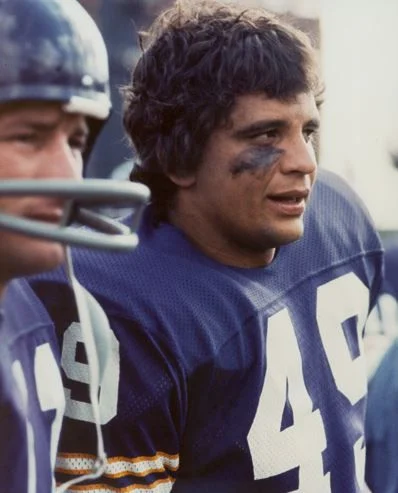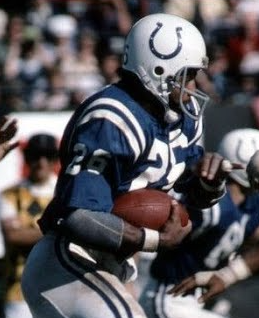The decade of the 1970s in pro football saw numerous offensive trends in strategy and in the application of personnel on every play. Changes were common on an annual basis, all in the hopes of finding better ways to gain yardage and thwart opposing defenses.
But a curious decision among several offensive coaches in the NFL around the middle of the decade saw running backs across the league doing more than just taking handoffs from their quarterbacks. The era of running backs leaving the backfield and running pass patterns downfield was blossoming in the 1970s, and quite a few teams found and used athletic runners who could both run and catch.
The decision to throw the ball more often to running backs stemmed from the things that the defenses were doing. Opposing pass rushers were bigger, stronger, and faster, and they were getting into the offensive backfield quicker and with more regularity in the early 1970s.
Moreover, opposing linebackers were blitzing more often, and they presented even more of a challenge to quarterbacks who were trying to locate and throw to their wide receivers downfield. It was becoming apparent that if an offense could not do an adequate job of keeping defenders out of the pass pocket for a long enough time for the quarterbacks to set up and throw the ball, something else had to be done to successfully get the ball downfield.
Enter the running backs. Their pass routes as they left the offensive backfield were naturally shorter in distance than most of the routes that the wide receivers were running. Moreover, it typically took the running backs less time to find an open space in the flat, or just past the line of scrimmage.
When quarterbacks in the 1970s were dealing with unblocked blitzers or a pass rush that was penetrating the pass pocket too quickly, it only made common sense to dump the ball off to one of his running backs. Those linebackers and defensive linemen who did manage to get close to the quarterbacks would thus take themselves out of a play if the passer got rid of the ball quickly to his running backs. By the end of the 1970s, tossing the ball to running backs and using them as viable pass receivers was becoming much more of an option than it was in all the previous decades of pro football.
 |
| Fred Willis |
The first modern running back who really seemed to wake up the game’s offensive strategists was Fred Willis of the Houston Oilers. In 1973, Willis managed to lead the entire American Football Conference (AFC) in pass receptions by snaring 57 passes.
In the run-happy NFL, Willis’ achievement was a watershed breakthrough of sorts. Suddenly, other teams began to see the potential for employing runners who had great hands, and who did not mind meandering out of the pass pocket to catch the football on a regular basis.
 |
| Chuck Foreman |
Ironically, the NFC had one such running back as Willis, and he displayed his talents in the very same year as Willis. Minnesota tailback Chuck Foreman burst onto the scene as a rookie in 1973, and he easily became the choice for the league’s Offensive Rookie of the Year honors.
Foreman had a little more speed than Willis, and he had the moves of a spinning top. Few running backs in the decade of the 1970s could outdo Foreman when it came to juking out an opponent. Foreman’s pass-catching prowess improved every year from 1973 to 1975.
In 1973, he caught 37 passes. In 1974, that number increased to 53 receptions. Then in 1975, he caught the most passes that he ever caught in one season with 73, which was enough to lead the entire league. Foreman also led the NFC in touchdowns in 1975 with 22.
He was just too talented to be ignored, and so the Minnesota offense just kept finding new ways to throw him the ball. Foreman ran practically any pass pattern out of the backfield that you can think of, and he ran them all to perfection. His ability to get open on almost every play kept the NFL’s defenses guessing.
It seemed that the more passes that Chuck Foreman caught, the more his quarterback, future Hall of Famer Fran Tarkenton, relied on him. quarterbacks during the 1970s were typically carrying the mindset that they needed to locate their wide receivers downfield first, and then look to their running backs as a viable option only if their receivers were covered downfield.
Running backs for the longest time were simply a drop-off option. That was not the case with Tarkenton. He would initially look to his running backs much more often than most quarterbacks in the league. Once Foreman caught the ball, anything could happen, thanks to his unpredictable moves out in the open field.
Once defenders started paying more attention to Foreman, it enabled Tarkenton to increase his throws to his wide receivers. But he also threw to his other running backs, and in particular to Ed Marinaro, a halfback who may have had the best pass-catching hands on the team.
Other teams around the league took notice of what Tarkenton, Foreman, Marinaro, and the Vikings were doing. They saw what yardage Minnesota’s offense was accumulating. Many teams decided to start looking for a running back in the draft or via free agency with similar qualities and talents as Foreman.
The Baltimore Colts had one such running back in Lydell Mitchell, who was Baltimore’s starting tailback. By the 1974 season (his third year in the NFL), Mitchell was also roaming out of the offensive backfield and looking to catch some passes. In 1974, he caught a lot of them…72 in fact. That was a good enough statistic to lead the entire NFL in pass receptions.
To those who may have thought that his accomplishment was a fluke, Mitchell repeated the honor of leading the league in receptions again in 1977 with 71 catches. Truly, Lydell Mitchell was not your basic run-of-the-mill running back. Like Foreman, he was a talented pro who had defensive coaches guessing and flustered as to what he would do next.
But Mitchell was a little bit different than players like Willis, Foreman, and Marinaro. Mitchell had a dose of brute strength and power to go with his trusty hands. When Mitchell got anywhere near the goal line, one had better watch out. He did not juke his way out of attempted tackles at that point. Rather, he simply lowered his head and blasted through them. Some running backs have a nose for the goal line, and a desire to cross it that is just too imposing to be ignored. Lydell Mitchell was one such running back.
 |
| Preston Pearson |
As the decade of the 1970s started coming to its close, a new kind of running back-turned-receiver emerged. It was the beginning of an age of specialization in the NFL, where certain players were used specifically for something that they brought to their team that virtually nobody else could do. One such player was Preston Pearson of the Dallas Cowboys.
Pearson came to Dallas after playing first for the Baltimore Colts, then the Pittsburgh Steelers. Dallas head coach Tom Landry immediately signed Pearson to a contract after Pittsburgh waived him, and that wise decision by Landry gave his offense a whole new weapon. Pearson by the late 1970s became known as one of the NFL’s most efficient third down backs. He would typically stand on the sidelines during first and second down, then join the offensive huddle for third down. Opposing defenses soon knew what to expect next.
Preston Pearson was one of the most thorough athletes in the game. He possessed two of the largest hands in pro football, and he caught practically any ball his fingers touched. There are numerous instances of him running out of the offensive backfield, then diving for overthrown or underthrown passes, most of which he caught.
Like Foreman, Preston Pearson’s number of receptions increased with almost every passing year during the latter part of the 1970s. His best season as far as statistics were concerned was in 1978, when he snared 47 passes. Considering that he was spending most of his time on the field only on third downs, that number of receptions is quite an accomplishment.
In conclusion, the decade of the 1970s in the NFL saw the idea of using running backs as receivers become an accepted part of offensive strategy. Thanks to the actions and results of players like Fred Willis, Chuck Foreman, Ed Marinaro, Lydell Mitchell and Preston Pearson, it became a very successful segment of pro football strategy.
Joe Zagorski is a member of the Pro Football Writers of America and the Pro Football Researchers Association. His upcoming book about the 1973 Buffalo Bills entitled The 2,003-Yard Odyssey: The Juice, the Electric Company, and an Epic Run for a Record will be released by Austin-Macauley publishers (New York) later in 2023.




I saw Preston Pearson play at the University of Illinois, except he played basketball, and was considered a defensive stopper at 6-1.
ReplyDeleteHe was drafted by the Colts in an era when teams started to follow the Cowboys' example of drafting great athletes from other sports in later rounds. He had a great year for the 1968 13-1 Colts, running back kicks and as a special teams ace and playing a part-time role as a running back.
From Brian wolf ...
ReplyDeleteIn hindsight, you have to wonder if Pearson's playmaking ability wouldnt have made more a difference in SB III? Matte was the starter and ran beautifully in that game but wasnt a breakaway threat that the Jets worried about like a Charlie Smith or Dickie Post. Had the Colts taken better advantage of Matte's running and receiving they would have won but trailing throughout, you wonder had Pearson played more, could he had given them the shot in the arm the team needed? I felt the same about way about Clint Jones against the Chiefs in SB IV. Could he have given the Vikings more speed and big play ability rather than starter Dave Osborn? Though teams stick with the players that brought them to the dance.
Mitchell and Foreman had careers that ended too soon but damn could they play! I dont know why Mitchell couldnt prosper more in SD--maybe injury--yet if any player during the 70s deserves the "Terrell Davis" consideration for the HOF despite injuries, its Foreman.
I'm going to ask John Turney to "take your toys away too", Brian....IF Earl Morral had thrown the flea flicker to a wide open Jimmy Orr (which worked to perfection earlier in the year against Atlanta) and/or IF the td pass that bounced off Tom Mitchell's shoulder pads hadn't bounced, and/or IF 5 or 6 other freakish things hadn't happened, SB III would (SHOULD) have been just another blowout....IF a bunch of other freakish things hadn't happened, the US Hockey team wouldn't have beat the Russians in 1980,etc. etc. etc....PLEASE give SBIII a rest unless it's the specific topic....criminy....
ReplyDelete